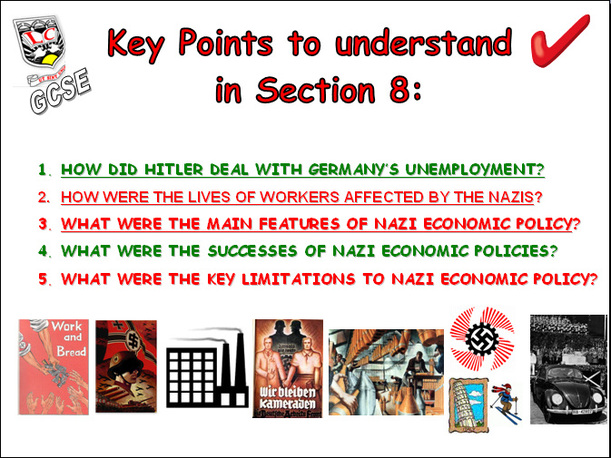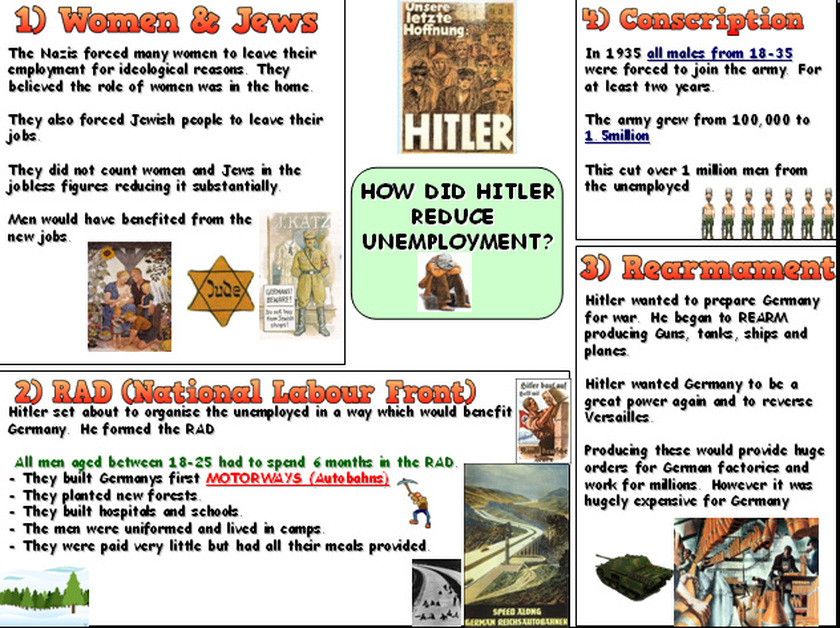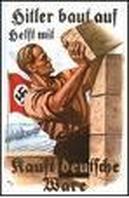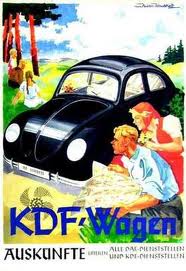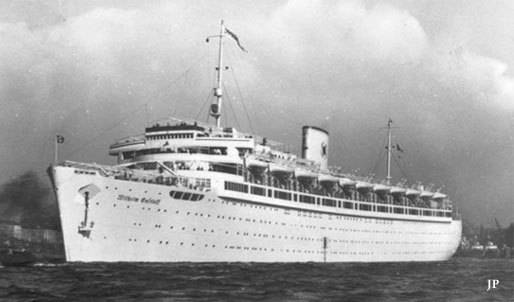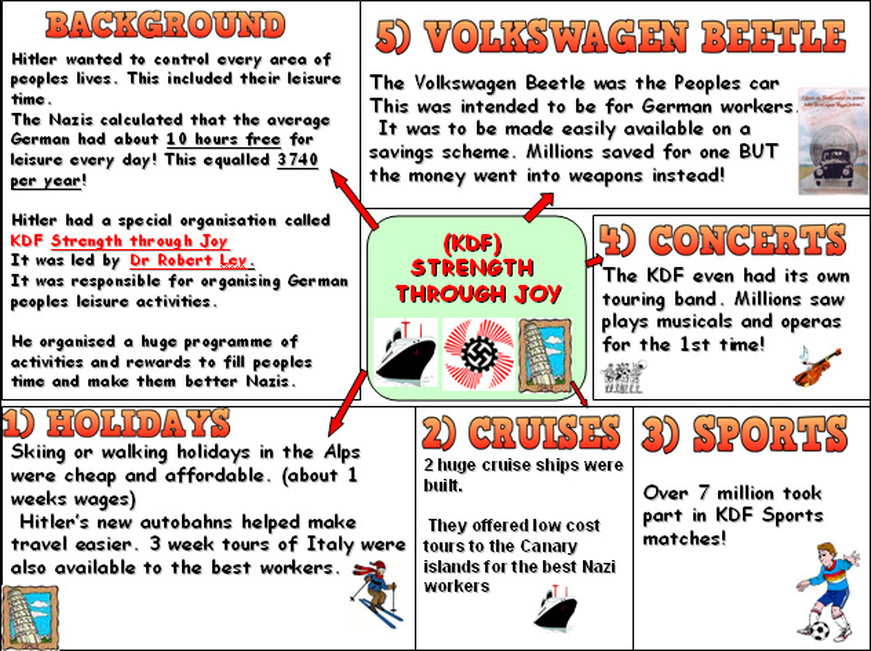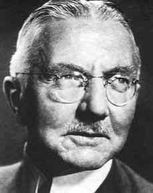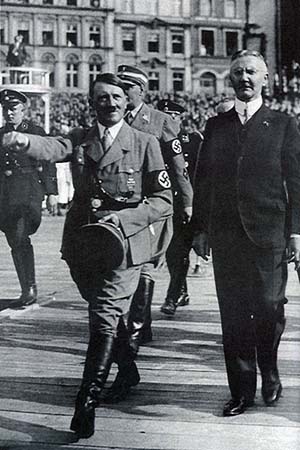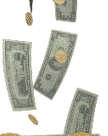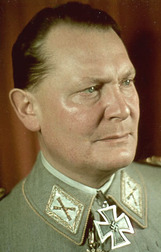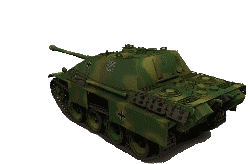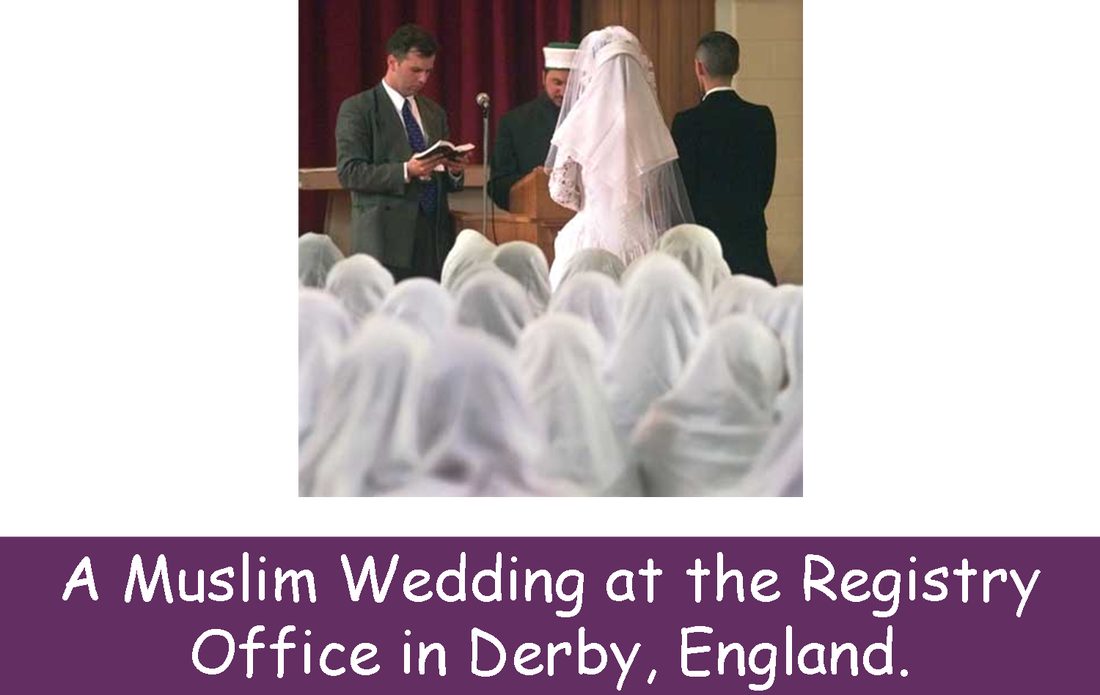How did the Nazis try and control the economy and were they successful?
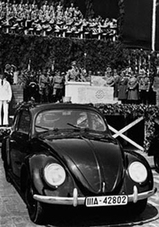
One MASSIVE factor helping Hitler to power was the economic DEPRESSION. You must know this!
The Great Depression started in 1929 in Wall street - the heart of Americas financial system. After years of very strong economic growth the US financial markets began to panic leading to stocks and shares in Wall street falling very fast in value. Millions of people lost their savings and investments, banks went bust, industries slowed, businesses closed down, unemployment went up fast AND like a virus this spread to other countries - like Germany.
The Nazis were swept to power on a wave of promises to DEAL with this economic depression. While democratic Weimar governments were weak, unstable and could not come up with solutions, Hitler and his Nazis seemed to offer the promise of 'WORK AND BREAD'
Out of all the Nazis policies, the way they dealt with the economy was in many ways seemed a HUGE SUCCESS.
However as with all Nazi policies - scratch below the surface and you will find UNDERLYING WEAKNESSES.
As a GCSE student you MUST be able to know and understand the changes the Nazis made economically, their Successes and their Failures
The Great Depression started in 1929 in Wall street - the heart of Americas financial system. After years of very strong economic growth the US financial markets began to panic leading to stocks and shares in Wall street falling very fast in value. Millions of people lost their savings and investments, banks went bust, industries slowed, businesses closed down, unemployment went up fast AND like a virus this spread to other countries - like Germany.
The Nazis were swept to power on a wave of promises to DEAL with this economic depression. While democratic Weimar governments were weak, unstable and could not come up with solutions, Hitler and his Nazis seemed to offer the promise of 'WORK AND BREAD'
Out of all the Nazis policies, the way they dealt with the economy was in many ways seemed a HUGE SUCCESS.
However as with all Nazi policies - scratch below the surface and you will find UNDERLYING WEAKNESSES.
As a GCSE student you MUST be able to know and understand the changes the Nazis made economically, their Successes and their Failures
|
|
|
1) TRADE UNIONS REPLACED |
A Trade Union is simply an organisation set up to protect workers rights. They are to stop employers being unfair and to campaign for better wages or working conditions.
The Nazis wanted COMPLETE CONTROL.
|
3) FREE TIME |
The Nazis did not want German citizens to have any time to think for themselves. They also wanted to control their FREE TIME!
A busy person doesn't have time to question. Hitler set up an organisation to occupy Germans leisure time. It was called the KDF or STRENGTH THROUGH JOY.
|
WHAT WAS STRENGTH THROUGH JOY (KDF) ?
Hitler and the Nazis were obsessed with controlling every aspect of German life. The economy was no exception:
Hitlers aim was to make up for the workers loss of trade union representation by making their lives better - and therefore keeping the workers happy.
Hitlers Economic policies
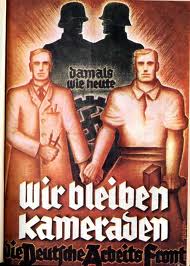
Hitler came to power based partially on his promises of what he could do for Germany - Could he live up to these promises?
He knew Germany would judge him on how he dealt with these crucial economic issues. He took steps to address the economy straight away.
He had THREE main Economic aims when he came to power:
He started off with 5 major policies (ideas)
He knew Germany would judge him on how he dealt with these crucial economic issues. He took steps to address the economy straight away.
He had THREE main Economic aims when he came to power:
- Reduce Unemployment
- Control the Economy
- Make Germany ready for War
He started off with 5 major policies (ideas)
- He BANNED TRADE UNIONS in May 1933. This reduced the power of people to strike. Wages were then kept low and competitive. Industry and factory owners really liked this as it kept their costs down. It also allowed them to employ more.
- WOMEN and JEWISH people were also gradually removed from employment. This reduced unemployment as unemployed men could take over these positions.
- CONSCRIPTION was introduced. Conscription is when men of a certain age usually 18 have to complete a set time in the army. This reduced unemployment further and built up the army!
- REARMAMENT - Hitler set about rearming Germany. Guns, tanks, weapons, planes were built to strengthen the army navy and air force. This boosted Germanys factories and decreased unemployment.
- PUBLIC WORKS SCHEMES were introduced. The NATIONAL LABOUR SERVICE (RAD) was set up. This was an organisation for 18-25 year olds (mostly unemployed) They planted forests, built homes and built a massive 3,000 Kms of AUTOBAHNS (Motorways) across Germany. This reduced unemployment and was very popular.
THERE WERE TWO STAGES TO NAZI ECONOMIC POLICY:
1) SCHACHT'S NEW PLAN
|
Under Schacht’s guidance the German economy recovered.
|
2) GORING'S FOUR YEAR PLAN
|
The SECOND economic stage was from 1936-39 when Hitler wanted to PREPARE GERMANY FOR WAR.
HOWEVER:
|
|
|
|
there were a number of areas where the nazis did seem to provide successes economically.
- Most importantly Unemployment fell dramatically - From 6 million in 1932 to under 500,000 in 1939! A massive success.
- His RAD work schemes were very successful - they helped reduce unemployment, were popular with the public, they taught men new skills and they led to major public improvements
- Major improvements such as Autobahns, Land reclamation and new forests.
- Working conditions were improved with Strength through Joy and the Beauty of Work programmes. Workers benefited from new sports clubs and affordable holidays.
- Consumer goods became very popular and industrial production grew strongly
- Germany was stronger and more self sufficient. Its army was only being built up to that of a European power?
HOW DID THE SOCIAL CLASSES BENEFIT?
1. UPPER CLASS
The Upper classes and factory owners feared Communism. They welcomed the Nazis strong stance against Communism and many factory owners gave huge donations to the Nazi party in return
Factory owners also were extremely happy with Hitler banning the Trade Unions. This meant they could keep wages down keeping their expenses low and making products cheaper and more affordable. Government contracts for weapons boosted profits hugely!
The Upper class also took pride again in Germanys new found strength and organisation
2. MIDDLE CLASS
Hitler relied on the Middle class as they made up so much of German society. The Middle classes widely supported Hitler. They were very happy with the new sense of control. They welcomed Economic growth and jobs and stability. They also welcomed Communism being controlled.
3. WORKING CLASS
The Working class traditionally supported Left wing or communist parties. Hitler however had managed to persuade a large proportion to become Nazis- through the SA, Propaganda and his ideas. Hitler had also delivered - He had provided jobs and seemed to be making Germany great again. Schemes like the KDF - Strength through Joy - were popular with workers
as with a lot of things with the nazis, not everything was as it seemed. there were indeed underlying limitations with their economic policies.
Unemployment did fall BUT this was the result of a few factors BUT what was this based on? :
HOW DID THE SOCIAL CLASSES LOSE OUT?
1. UPPER CLASS
Despite the economic growth experienced by factory owners many could see this was all to do with Germany rearming which could not be sustained. Nazi officials also increasingly interfered with factory production in order to raise it to a war footing.
2. MIDDLE CLASS
The Middle class did benefit BUT many still struggled to make a living. small businesses still struggled to survive and many could not afford to buy consumer goods (like electrical items for the home)
3. WORKING CLASS
Jobs were now available BUT at low wages. Trade unions were banned so they could not argue over wages. They had less rights and worked longer hours for low pay
- He removed Women and Jews from the workforce - these were not counted in unemployment figures
- The Nazis fiddled with the unemployment figures to make them look better than they were
- The RAD was successful BUT it kept men in low paid controlled employment.
- The Autobahns too were successful BUT they were intended for war - They could be used to transport troops quickly to war zones.
- Working conditions did improve BUT mostly only for Nazi party members
- The Volkswagen car for example was never delivered to a German citizen as production went into the war
- Germany did experience industrial growth BUT it was a lot to do with REARMAMENT -and preparing for war - Dr Schacht proved this by resigning.
- Germany was NOT self sufficient by 1939 - It still imported 1/3rd of its raw materials.
- The 4 year plan worked well in the SHORT TERM - when Germany was fighting and winning at the beginning of the war. However it was not good in the LONG TERM - Germany suffered due to bombing and having to fight a WORLD WAR.
HOW DID THE SOCIAL CLASSES LOSE OUT?
1. UPPER CLASS
Despite the economic growth experienced by factory owners many could see this was all to do with Germany rearming which could not be sustained. Nazi officials also increasingly interfered with factory production in order to raise it to a war footing.
2. MIDDLE CLASS
The Middle class did benefit BUT many still struggled to make a living. small businesses still struggled to survive and many could not afford to buy consumer goods (like electrical items for the home)
3. WORKING CLASS
Jobs were now available BUT at low wages. Trade unions were banned so they could not argue over wages. They had less rights and worked longer hours for low pay
Downloadable Resources
PRESENTATIONS
|
DOCUMENTS/HANDOUTS
| ||||||||||||||||||||||||||||||||||||||||||
